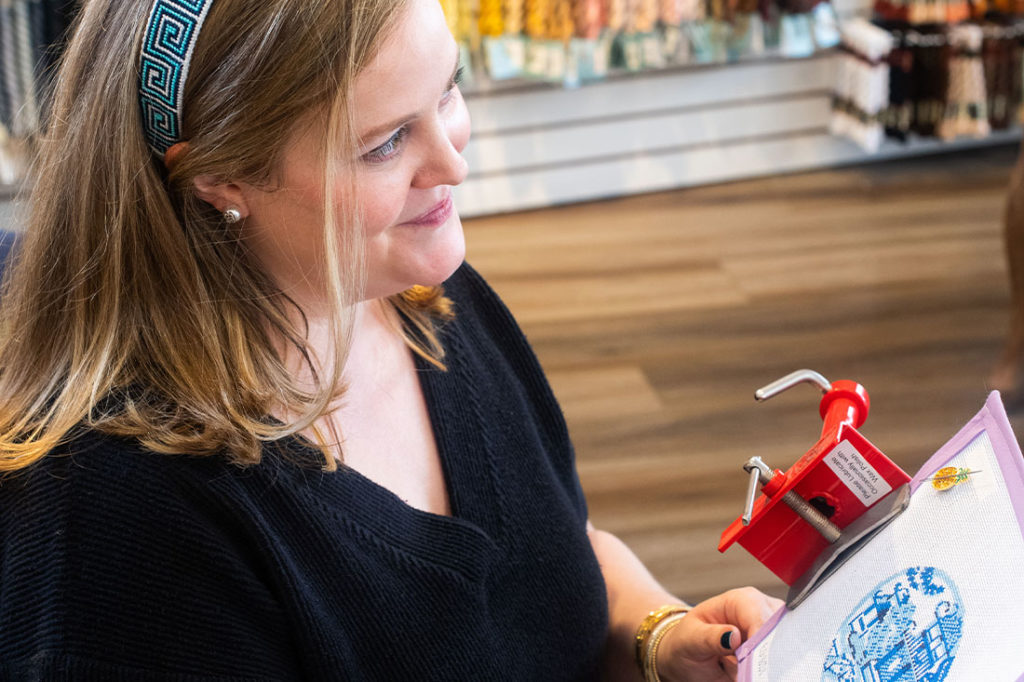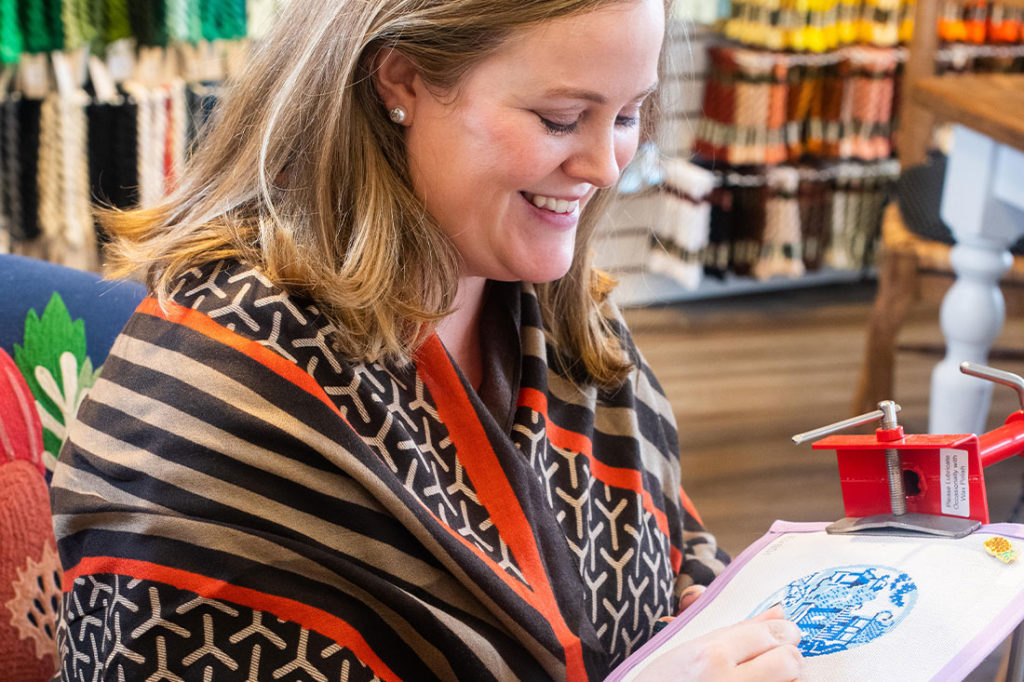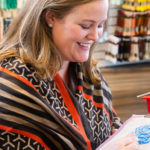I’m driving home from one of Atlanta’s popular new restaurants. For the past few hours, I have been gabbing and sipping French wine with 15 friends. We covered everything from the latest binge-worthy shows to hilarious dating adventures. While the posh setting complete with crystal chandeliers and plush velvet club chairs is what Instagram dreams are made of, everyone was more interested in creating something with their fingers than they were scrolling technology with them. It was the inaugural Stitch Club Atlanta meeting of 2022, a group that meets the third Thursday of the month to needlepoint with each other.
Needlepoint is a centuries-old craft dating to ancient Egypt. It became a prominent domestic pastime in the 16th century, and eventually worked its way into home decor through elaborate tapestries and detailed upholstery. The hobby is traditionally thought of as being passed down from one generation to another, with family heirlooms like Christmas stockings being among the most cherished pieces.
Stitchers work on a flexible open-weave canvas piercing silk, wool and other fiber-blended threads back and forth through their colorful, hand-painted canvases. Skilled needleworkers mix decorative stitches, thread types and even beads to create intricate handheld works of art. It’s a sophisticated paint-by-numbers of sorts. Once a canvas is complete, it can be transformed into everything from pillows and sleep masks to acrylic trays and picture frames.
Today, the rise of social media, and specifically Instagram, has propelled the activity to “cool” status among millennials and Gen Zers. There are needlepoint influencers and a new generation of online-only needlepoint retailers. And there’s me, a self-taught hobbyist.
Generation Zen
A few years ago, I decided enough was enough with endlessly scrolling my social media feeds. I needed something to do—a hobby—that would force me to put my phone down and redirect my attention and my thumbs. Ironically, during one of my mindless scrolling sessions, I saw a needlepoint canvas that read, “I am not for everyone.” I laughed aloud and found myself in the black hole of cheeky needlepoint designs. The next day, I sought out an LNS (that’s insider talk for local needlepoint store). I stitched my first piece in four days. The second in two weeks. Pretty soon, my stash of canvases outnumbered what my fingers could produce. I was hooked.

“I put hobbies under the big umbrella of fun,” says licensed counselor Mazi Robinson. “When we’re kids, life is all about fun. As we move into adulthood, we lose touch with fun. We lose touch with purposeless spending of time. It’s mentally healthy to say, ‘I’m doing this for myself because I think it’s fun, because I enjoy it, and because it brings me joy.’ That’s why hobbies are important.”
Doing something without the desire to turn it into a money-making venture is all but lost in today’s hustle-culture climate. In fact, a 2020 LendingTree survey found that half of millennials have a side hustle, and most rely on it for income. At what point did we decide every hobby or passion had to become a gig? It’s exhausting, and it misses the relaxation factor our minds crave.
Allowing our brains an opportunity to unplug is not something we should have to earn, but something we should prioritize because we deserve it.
“In a lot of ways, we deny ourselves happiness by bowing down to the throne of purpose and productivity,” Robinson says. “Hobbies and doing something that you genuinely enjoy is a huge part of our physical and mental restoration process.”
Jan Rogers, owner of The Nimble Needle in Atlanta, describes stitching as meditative. “It’s breathing. In and out, in and out, every time you go through the canvas. Some people even say it’s prayerful. It’s the time we have to sit and reflect.”
Spreading the Love
When I arrived at my beginner’s class in summer 2018 as an eager 32-year-old, I was the youngest stitcher by at least 20 years. I was peppered with questions about how long I had been stitching, and how many projects I had done. My favorite joke was that I had finally found a hobby that took as much time and cost as much cash as my husband’s golf outings.
Over the next few months, I found myself visiting my LNS regularly. I latched onto the expert stitcher employees, women decades older than me—with stitching wisdom, of course, but also with warm, welcoming personalities. They were thrilled by the “youthful crowd” taking up the hobby. We exchanged phone numbers and Instagram handles. I helped them learn more about the social media platform that was catapulting other LNS’s like Lycette Designs in Palm Beach to viral success. They helped me navigate new stitches and thread types.
“There is so much we can all learn from each other. We were a part of the regimented stitching generation, but the younger stitchers give us some freedom,” Rogers says. “Obviously, with owning the shop, I have very little stitching time, but I get to experience the joy through watching the younger crowd learn and grow. Plus I learn and grow from them.”
By spring 2019, my Instagram feed had transformed from blogging personalities to like-minded needlepointers across the country. Stitch Clubs were formed in more than 100 cities around the world. In Atlanta, we met in elegant hotel lobbies, abstract artist studios, dessert shops and wine bars. The goal? Simply to gather and stitch. When our original Atlanta leader relocated to New Jersey for work, I captained the helm. I established a regular meeting schedule and started recruiting friends and family to come to our meetups. My 25-year-old sister was stitching. My BFF of 10 years was stitching. My copywriting client was stitching. And not because they were looking for their next side hustle, but because they genuinely loved the hobby.
Fostering Friendship
I began taking my needlepoint obsession on the road. In each city I visited, I insisted on checking for an LNS. I took a spontaneous one-on-one French knot class at Flying Needles in Belleair Bluffs, Florida. I stopped by Nashville Needleworks in Brentwood, Tennessee. I had a needlepoint friend, Alexandra, whom I only knew from Instagram, pick me up from Chicago Union Station so we could spend the day together shopping at Stitchers Garden in Naperville, Illinois. In late 2021, I flew to Dallas for a stitcher meetup and dinner hosted by Jessica Meyers, owner of Lycette Designs, and Melissa Smrekar, a Dallas micro-influencer with her own needlepoint canvas line. There, more than 20 men and women spent the evening discussing needlepoint.
Smrekar emphasizes that although the collaboration was a smashing success (it sold out within an hour of the collection launching), the crux of the craft is that it brings people together. “A sense of community fostered by the shared love of a craft isn’t new. What has expanded, though, is the breadth and depth of the needlepoint community because of social media. While we found catharsis in the craft during a period of unforeseen isolation, we also found friendship.”
It’s hard to meet new people in adulthood. “Adult friendship is the big mystery that no one talks about, but common interest is a great foundation to be built on. Normally there’s going to be some similarities in personalities, too, because you get each other; you get the joy and the fun that the other person feels when they complete one of their needlepoint projects. That common ground is so valuable,” Robinson adds.
Needlepoint has landed me a solid group of friends ranging in age from 27 to 46 whom I text daily about the best stitch selections and our works in progress. Some of my favorite stitching sessions over the years have included chats with baby boomers about their kids while we giggle over our respective “inappropriate” canvases, and I watch in awe of their stitching skills—skills I hope to develop one day.
“I like to say ‘Nice Girls Forever,’ and I think needlepoint is a community of just that: nice girls (and nice guys). We offer each other advice, encouragement, praise and camaraderie,” Smrekar says. It’s a friendly community with bountiful benefits. “Who wouldn’t want to be a part of the group? You can always sit with us!”
As I drive, I stretch my jaw. It’s sore from laughing at Stitch Club. My windshield wipers toss rain off my car. It’s a dreary, frigid January evening. In fact, Atlanta is expecting winter weather overnight, something Southerners both welcome and rebuff. On one hand, the threat of snow and ice means panicked grocery hauls and breaking meteorology updates. On the other, it’s an excuse to snuggle under blankets, blame power outages for internet trouble and take the day off from work. For me, it’s the promise of an entire day devoted to needlepointing.
This article originally appeared in the May/June 2022 Issue of SUCCESS magazine. Photos by Angela Webb.






